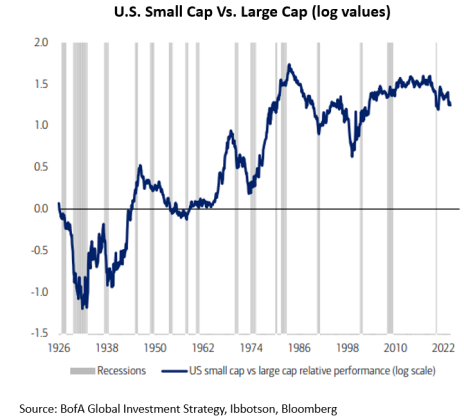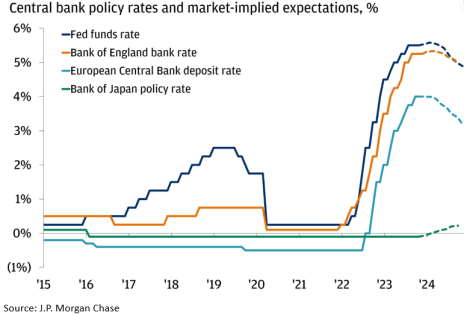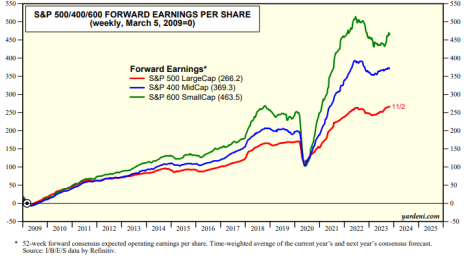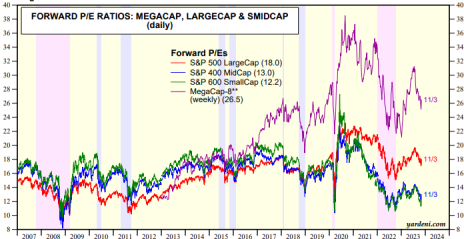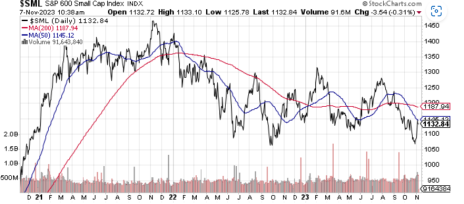Over the long run, small-cap stocks have outperformed the market. But since 2020, they’ve lagged. What’s the deal? Can small-cap stocks regain their leadership position, and if so, when?
Before we get to where small caps could go in the future a quick look back is in order.
Since 1926, small-cap stocks have done better than large caps, delivering average annual returns of 16% versus 12%. Obviously, some years are better than others. Over the long haul, it works out that small does better than large in roughly three out of every five years.
The big-picture reason behind small-cap outperformance is that economies tend to grow over the long haul and, as a general rule, small caps have more leverage to that growth.
That all said, there have been periods marked by significant small-cap underperformance. The biggest ones being in the 1930s, 1946 – 1964, 1983 – 1999, and 2020 – 2023.
[text_ad]
Naturally, the most recent three-year period is what we feel the most since it’s our recent/current lived experience. In the 2020s small cap average annual returns have been around 8%, versus 13% for large caps.
The big-picture reason behind recent small-cap underperformance is high inflation mixed with high interest rates. That combo limits credit availability to smaller companies and puts downward pressure on perceived “riskier” investments, which includes small caps.
There are also major segment and market exposure considerations that have helped large outperform small. For instance, the small-cap indices are much more levered to financials and healthcare, which have significantly underperformed over the last three years.
There is also no comparison in the small-cap indices to the mega-cap tech stocks that have delivered the bulk of large-cap returns recently.
That’s the past. What about the future?
The good news is that a resurgence in small-cap outperformance may be coming. Remember that history shows small caps tend to outperform in three out of every five years. That alone may be enough to close the argument. But let’s not stop there.
The Fed (and Other Central Banks) Are Likely Done Hiking
Last week FOMC members unanimously elected to hold rates steady here in the U.S. After the decision, Fed Chair Jerome Powell’s press conference commentary was far less hawkish than after previous meetings, bordering on dovish. The Bank of England and European Central Bank also seem at or near the end of their tightening cycles. Generally speaking, peak rates should be good for stocks, especially riskier equities like small caps.
Earning Growth Could Accelerate
Forward earnings expectations are one of the biggest drivers of stock market performance. That’s been bad news for stocks over much of the last two years as earnings growth rates have declined. However, current consensus estimates suggest that the downtrend is coming to an end and could reverse course in the current quarter (Q3) then trend upward through 2023. While this is true for large-, mid- and small-cap stocks, as the chart below from Yardeni Research shows the pullback in earnings (EPS) has been most pronounced in small-cap stocks (the green line). A return to earnings growth for small caps could drive a resurgence in investor interest in the asset class.
Small-Cap Stocks Trade at a Discount
Stock valuations might not matter a lot on a day-to-day basis but they matter a lot over the long haul. Right now, small-cap stocks are cheap, not just on an absolute basis but on a relative basis as well. The forward PE of the S&P 600 Index (green line in chart below) is just 12.2. That’s well below the average (both long and short-term). And relative to large caps, which trade with a forward PE of 18, small caps are especially attractive.
Lower Uncertainty Translates to Upside Potential for Stocks
It would be an understatement to say investors have been dealing with a ton of uncertainty in recent years. For sure, the world is far from perfect today. But we’re starting to see a future where central banks aren’t trying to crush growth by hiking rates, inflation is trending down, supply chain disruptions are easing and many other of the big-picture issues of the last three years are coming into sharper focus. A more certain backdrop is typically good for stocks (even when some is “known bad news”), including small caps.
In terms of when small caps could start to outperform, the reality is that trying to time things perfectly is impossible. Run from anybody who tells you differently!
But stepping back, the S&P 600 Small Cap Index appears to be at a depressed level, even after a nice rally last week.
Factoring in technical, fundamental and investor sentiment considerations, it’s likely a good time to ramp up small-cap stock exposure. For the most conservative, that means a good ETF or mutual fund.
For the more aggressive that means individual small-cap stocks. If you’re interested in what I’m recommending for specific stocks I’d love to have you try Cabot Small-Cap Confidential. One of my recent ideas is a small-cap software stock that’s a play on Artificial Intelligence (AI).
For details on that stock, as well as other recommendations, snag a trial subscription (just for my readers) by clicking here now.
[author_ad]

